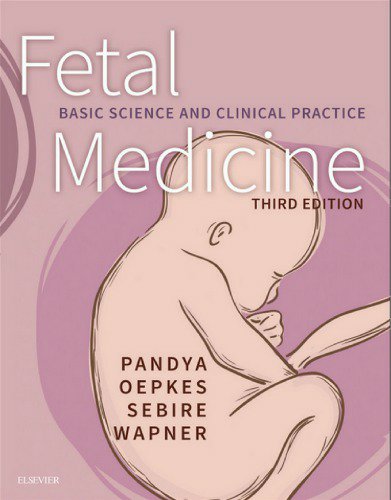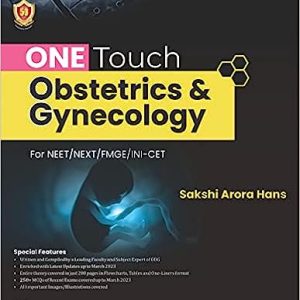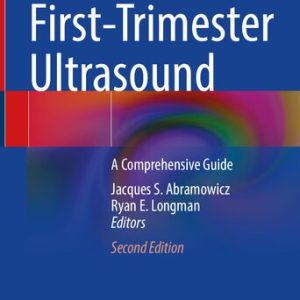Table of contents :
Fetal Medicine: BASIC SCIENCE AND CLINICAL PRACTICE……Page 2
Copyright……Page 3
Foreword……Page 4
Preface……Page 5
List of Contributors……Page 6
Origin of the Early Embryological Terms……Page 13
Embryonic Cells in Culture……Page 14
Computing Sciences and Embryological Terminology……Page 15
Conclusion……Page 16
References……Page 17
The Cytoskeleton……Page 18
Epithelia……Page 20
Mesenchymal Cells……Page 22
Embryonic Induction and Cell Division……Page 24
The Cell Cycle……Page 25
Instructive Interactions……Page 26
Neural Ectoderm and Neural Crest Mesenchyme Interactions: The ‘Fly-Paper Model’ of Skull Development……Page 27
Surface Ectoderm and Somatopleuric Mesenchymal Interactions in the Limb……Page 29
Intraembryonic Mesoderm and Intermediate Mesenchyme Interactions……Page 31
Other Cells Types Affecting or Affected by Local Interactions……Page 32
Conclusion……Page 34
References……Page 35
Human Stage Series……Page 36
The Stage 11 Embryo, Body Plan Stage……Page 37
Obstetric Timing and Staging of Embryos and Fetuses……Page 40
Conclusion……Page 42
References……Page 43
Mechanisms of Teratogenicity……Page 44
Underlying Principles……Page 45
Medication……Page 46
Environmental Agents……Page 48
Selected Infections……Page 49
Selected Recreational Exposures……Page 50
Conclusion……Page 51
References……Page 52
Congenital Uterine Anomaly……Page 55
Normal Intrauterine Pregnancy……Page 56
Early Embryonic Demise……Page 57
Ultrasound Features……Page 58
Recurrent Miscarriage……Page 59
Risk Factors for Ectopic Pregnancy……Page 60
Tubal Ectopic Pregnancy……Page 61
Surgical management……Page 62
Conclusion……Page 63
References……Page 64
Nidation……Page 67
Trophoblast Interaction with Extracellular Matrix……Page 68
Matrix Degradation by Trophoblast……Page 69
Leukocyte Populations in Decidua……Page 70
Maternal KIR–Fetal HLA-C Combinations Influence Reproductive Success……Page 71
Conclusion……Page 73
References……Page 74
The Placenta at Delivery……Page 75
Haemochorial Placental Blood Flow……Page 76
Phenotypes of Extravillous Trophoblast……Page 77
Small Spindle-Shaped Extravillous Trophoblast Cells……Page 79
Transformation of the Uteroplacental Arteries……Page 80
Flow of Maternal Blood into the Intervillous Space……Page 82
Architecture of the Villous Trees……Page 83
Villous Development……Page 84
The Placental Barrier……Page 86
Physiology of Fetoplacental Blood Flow……Page 87
Conclusions……Page 88
References……Page 89
The Placental Exchange Barrier……Page 91
Types of Exchange Mechanisms……Page 92
Factors Affecting Maternofetal Exchange……Page 93
Ions……Page 94
Amino Acids……Page 96
Immunoglobulin G……Page 97
Clinical Considerations: Maternofetal Exchange and Fetal Growth Restriction……Page 98
Conclusions……Page 99
References……Page 100
Placental Pathological Assessment……Page 102
Prenatal Assessment of Specific Placental Pathologies……Page 103
Categories of Placental Pathologies……Page 105
Abnormalities of Placental Perfusion……Page 106
Primary Abnormalities of Villous Development……Page 107
Inflammatory Lesions……Page 108
Tumours and Tumourlike Lesions……Page 109
Conclusion……Page 110
References……Page 111
Brief Overview of Heart Development……Page 112
The Heart Fields……Page 113
Contraction……Page 114
Development of the Chambers and Outflows……Page 115
The Interventricular Septum……Page 116
The Atrioventricular Junction……Page 118
Outflow Tract……Page 119
Conduction Tissue……Page 120
Umbilical Veins……Page 121
The Arterial System……Page 122
Conclusion……Page 126
References……Page 127
Pseudoglandular Stage (5–17 Weeks)……Page 128
Structural Development……Page 129
Functional Development of the Pulmonary Circulation……Page 131
Changes at Birth……Page 132
Control of Fetal Lung Liquid Secretion……Page 133
Control of Fetal Lung Liquid Volume……Page 134
Regulation of Fetal Lung Growth……Page 135
Fetal Lung Hypoplasia……Page 136
Epithelial Cell Differentiation……Page 137
Conclusions……Page 138
References……Page 139
Timeline of Kidney Development……Page 141
The Metanephros……Page 142
Final Nephron Number……Page 143
Causes of Human Renal Anomalies……Page 144
Genetic Factors……Page 145
Potential Adverse Effects of Prematurity……Page 146
Conclusions……Page 147
References……Page 148
Introduction……Page 150
Legal Aspects, Aims and Types of Autopsy……Page 151
Internal Examination……Page 152
Retention of Organs……Page 153
Postmortem Imaging……Page 154
Hypoxic Ischaemic Changes……Page 155
Respiratory Anomalies……Page 156
Musculoskeletal Anomalies……Page 157
Postfetal Intervention……Page 158
Conclusion……Page 159
References……Page 160
Randomised Controlled Trials……Page 161
Evaluation of Screening and Diagnostic Tests……Page 162
Analysing Databases and Survey Data……Page 164
Meta-analysis……Page 165
Conclusion……Page 166
References……Page 167
The Fetus as a Patient……Page 168
The McCullough and Chervenak Model……Page 169
Why the McCullough and Chervenak Model Is Flawed……Page 170
Rationale of Offering Fetal Treatment……Page 171
Saving the Fetus at What Price to the Child……Page 172
Giving the Child a Better Life……Page 173
Ethical Challenges of Fetal Therapy Research……Page 174
Reproductive Autonomy and Parental Responsibility……Page 175
Conclusion……Page 176
References……Page 177
Basic Parameters of Diagnostic and Screening Tests……Page 179
Likelihood Ratios……Page 180
Receiver Operator Characteristic Curves……Page 181
Cost Effectiveness of Prenatal Screening……Page 182
Conclusions……Page 183
References……Page 184
Why Good Practice in Information-Giving Is so Important……Page 185
Conveying Information About Risk……Page 186
Noninvasive Prenatal Testing Using Cell-Free DNA……Page 187
Prenatal Diagnosis of Fetal Anomaly……Page 188
Pregnancy Management After Diagnosis……Page 189
Information Needs When Parents Decide to Continue With an Affected Pregnancy……Page 190
Conclusions……Page 191
References……Page 192
Historical Perspective……Page 194
Prevalence According to Gestational Age……Page 195
Principal Down Syndrome Markers……Page 196
Covariables……Page 197
Markers in More Detail……Page 198
For Localities with High-Quality Ultrasound……Page 199
Detection of Trisomy 18 and 13……Page 200
Ultrasound Markers……Page 201
Anomaly Scan Results……Page 202
Renal Transplant……Page 203
Smith-Lemli-Opitz Syndrome……Page 204
Maternal-Fetal Conditions……Page 205
Cost Effectiveness……Page 206
Risk Calculation Software……Page 207
Conclusions……Page 208
References……Page 209
Anatomical Survey at 11 to 13+6 weeks (Fig. 19.1 and Table 19.1)……Page 212
Increased Nuchal Translucency (Fig. 19.4) and Structural Anomalies……Page 214
First Trimester Fetal Brain and Spine Investigation……Page 215
Most Common Brain and Neural Tube Anomalies……Page 216
Midline Defects……Page 219
Early Markers for Congenital Heart Disease……Page 220
Accuracy of Congenital Heart Disease Detection by Early Ultrasound Investigation……Page 221
How to Perform a Complete Early Fetal Echocardiography……Page 222
Conclusions……Page 223
Thorax, Diaphragm, Abdominal Wall and Bowel……Page 224
Abdominal Wall Defects……Page 225
Rare Intraabdominal and Abdominal Wall Anomalies……Page 227
Genetic Syndromes……Page 228
Conclusion……Page 229
References……Page 230
20 – Evidence for Routine Ultrasound Screening for Fetal Abnormalities in the Second and Third Trimesters……Page 233
RADIUS Trial……Page 234
Eurofetus Study……Page 235
Better Estimate of Gestational Age……Page 237
Equipment……Page 238
Resource Utilisation……Page 239
Conclusions……Page 240
References……Page 241
Fetal Cells in the Maternal Circulation……Page 243
Future Directions……Page 245
Cell-Free Fetal DNA in the Maternal Circulation……Page 246
Massively Parallel Sequencing and Next-Generation Sequencing……Page 247
Single Nucleotide Polymorphism……Page 248
Methylation-Based Technology……Page 249
Methods for Detection of Subchromosomal Abnormalities (Microdeletions and Microduplications)……Page 250
False-Negative Noninvasive Prenatal Testing Results……Page 251
Choice of the Confirmatory Diagnostic Procedure……Page 252
Conclusion……Page 254
References……Page 255
Introduction……Page 258
Fetal Sex Determination……Page 262
Noninvasive Prenatal Diagnosis for Monogenic Disorders……Page 263
Noninvasive Prenatal Diagnosis for Autosomal Dominant Conditions and Exclusion of Paternal or De Novo Mutations……Page 264
Noninvasive Prenatal Diagnosis for Autosomal Recessive and Sex-Linked Disorders……Page 265
Ethical and Social Issues……Page 267
Conclusions……Page 268
References……Page 269
Technique of Amniocentesis……Page 271
Fetal Risks of Amniocentesis……Page 272
Pregnancy Losses After Amniocentesis……Page 273
Technique……Page 274
Safety of Chorionic Villus Sampling in Multiple Pregnancies……Page 275
Fetal Blood Sampling……Page 276
Safety of Fetal Blood Sampling……Page 277
Conclusion……Page 278
References……Page 279
Prenatal Specimens……Page 284
Abnormal Screening Result……Page 285
Noninvasive Prenatal Screening Using Cell-Free Fetal DNA……Page 286
Chromosome Rearrangement or Copy Number Variant in a Parent……Page 287
Aneuploidy……Page 289
Long Contiguous Stretches of Homozygosity……Page 290
Karyotype……Page 291
Rapid Aneuploidy Detection……Page 293
Chromosomal Microarray……Page 294
Genotype–Phenotype Correlation……Page 295
Maternal Cell Contamination……Page 296
Concluding Remarks……Page 297
References……Page 298
Introduction……Page 301
What Is Next-Generation Sequencing, and How Does It Work……Page 302
How Are Next-Generation Sequencing Data, Such as Whole-Exome Sequencing Results, Analysed and Interpreted……Page 304
Multigene Panels……Page 305
Pretest Counselling……Page 306
Conclusions……Page 307
References……Page 308
Genetic Screening Using Molecular Techniques……Page 309
Expanded Carrier Screening……Page 311
Next-Generation Sequencing……Page 312
Premarital Carrier Screening Programs……Page 313
Couple Screening……Page 314
Pretest Counselling……Page 315
Posttest Counselling and Management……Page 316
Conclusions……Page 317
References……Page 318
No Functional α-Globin Genes: Hb Bart Disease or Homozygous α0-Thalassemia……Page 320
One Functional α-Globin Gene: Hb H Disease……Page 321
Homozygous β-Thalassemia……Page 322
Haemoglobin Electrophoresis and High-Performance Liquid Chromatography or Capillary Electrophoresis……Page 323
Workup for Screen-Positive Couples……Page 324
Detection of αo- and α+-Thalassemia Deletion……Page 325
Detection of Nondeletion α+-Thalassemia Mutations……Page 326
Ultrasound Exclusion of Homozygous α0-Thalassemia……Page 327
Other Noninvasive Testing for Homozygous α0-Thalassemia……Page 328
Noninvasive Prenatal Diagnosis for Thalassemia……Page 329
Conclusion……Page 330
References……Page 331
Introduction……Page 332
Ventriculomegaly……Page 333
Anomalies Related to Dorsal Induction Failure……Page 335
The classification of spinal dysraphism has been revised recently as shown in Fig. 28.16.41……Page 339
Anomalies of Prosencephalic Development……Page 341
Posterior Fossa Anomalies……Page 346
Disorders of Cortical Development……Page 349
Congenital Infections……Page 352
Destructive Lesions……Page 354
Vascular Malformations……Page 357
Intracranial Masses: Cysts and Tumours……Page 358
Conclusion……Page 361
References……Page 362
Screening for Congenital Heart Disease……Page 367
Prenatal Therapy……Page 368
Lesion with Abnormal Four-Chamber View……Page 369
Lesions Requiring Views of the Outflow Tracts……Page 377
Lesions Difficult to Detect Prenatally……Page 382
Arrhythmia……Page 384
Conclusion……Page 385
References……Page 386
Thoracic Malformations Detected on Prenatal Ultrasound……Page 388
Congenital Pulmonary Airway Malformations……Page 389
Pulmonary Sequestration……Page 390
Pulmonary Hypoplasia and Agenesis……Page 391
Cystic Lung Lesions……Page 392
Cystic Lung Lesions……Page 393
Pulmonary Agenesis and Hypoplasia……Page 394
Conclusion……Page 395
References……Page 396
Aetiology and Pathogenesis……Page 398
Prenatal Diagnosis and Outcome Prediction……Page 399
Antenatal Therapeutic Strategies……Page 402
Experimental Antenatal Treatments……Page 404
Conclusion……Page 405
References……Page 406
Embryologic Development……Page 408
Sonographic Features at 12 Weeks’ Gestation……Page 410
Sonographic Features after 28 Weeks’ Gestation……Page 411
Gastroschisis……Page 412
Exomphalos……Page 413
Bladder and Cloacal Extrophy……Page 414
Dilated Bowel……Page 415
The Liver……Page 416
Intraabdominal Calcification……Page 417
Conclusions……Page 418
References……Page 419
Embryology……Page 421
Normal Sonographic Development of the Fetal Kidneys and Urinary Tract……Page 422
Urinary Tract Anomalies……Page 424
Prenatal Management of Fetal Obstructive Uropathies……Page 428
Renal Abnormalities……Page 434
Anomalies of Position……Page 435
Abnormalities in Renal Size, Structure and Echogenicity……Page 436
Nonhereditary Cystic Kidneys Disease……Page 440
Bladder Malformations……Page 442
References……Page 443
Embryology and Sonographic Appearance of the Normal Fetal Skeleton……Page 445
Maternal Disease……Page 446
Abnormal Findings on Routine Ultrasound……Page 452
Timing of Diagnosis……Page 455
Osteogenesis imperfecta types IIA, IIB and IIC……Page 456
Thanatophoric dysplasia……Page 459
Asphyxiating thoracic dystrophy……Page 460
Ellis-van Creveld syndrome……Page 464
Osteogenesis imperfecta type IV……Page 465
Rhizomelic chondrodysplasia punctata……Page 466
Conradi Hunermann syndrome……Page 467
Other Skeletal Dysplasias Associated With Short, Straight Limbs……Page 468
Acromesomelic dysplasia……Page 469
Kniest dysplasia……Page 470
Limb Deficiency or Congenital Amputations……Page 471
Conclusions……Page 473
References……Page 474
Ultrasound Investigation of the Fetal Face……Page 475
Three-Dimensional Ultrasound of the Fetal Face……Page 476
Cross-Sectional Imaging……Page 477
Rendered Images……Page 478
Facial Clefts……Page 479
Ultrasound Examination of Facial Clefts……Page 480
Ultrasound Examination of Micrognathia……Page 483
Forehead……Page 487
Nose……Page 489
Jaws……Page 490
Mouth……Page 491
Eyes……Page 494
Ears……Page 495
Conclusions……Page 498
References……Page 500
Diagnosis of Hydrops Fetalis by Ultrasound……Page 502
Pathophysiology……Page 503
Cardiovascular Conditions……Page 504
Chromosomal Disorders……Page 505
Haematologic Conditions……Page 507
Lymphatic Dysplasia……Page 508
Metabolic Conditions……Page 509
Clinical Evaluation……Page 510
Fetal Assessment……Page 511
Fetal Therapy……Page 513
Prognosis and Recurrence Risk Counselling……Page 516
Conclusion……Page 517
References……Page 518
Cystic Lymphangioma……Page 520
Antenatal Management……Page 522
Intrapartum Management: The EXIT Procedure……Page 524
Postnatal Management……Page 526
Antenatal Management……Page 527
Conclusion……Page 529
References……Page 531
Lethal Conditions……Page 533
Pre- and Intraoperative Management……Page 535
The Surgical Procedure……Page 536
Postoperative Management……Page 537
Outcomes of Spina Bifida Aperta……Page 542
Outcomes of Congenital Thoracic Malformations……Page 544
Outcomes of Sacrococcygeal Teratoma……Page 545
Conclusions……Page 546
References……Page 547
Epidemiology……Page 549
Classification of Fetal Growth Restriction……Page 550
Fetal Factors……Page 551
Uterine Artery Doppler……Page 552
Ultrasonographic Biometry……Page 553
Ultrasonographic Biometry……Page 554
Confirmation of Gestational Age……Page 556
Ultrasound……Page 557
Potential Interventions……Page 559
Timing of Delivery……Page 560
Summary of Recommendations for Management of Fetal Growth Restriction……Page 561
Counselling……Page 562
Conclusion……Page 563
References……Page 564
Pathogenesis……Page 568
Fetal Response……Page 569
Rh Variants……Page 570
Kell……Page 571
Other Rare Antigens……Page 572
Indirect Coombs Test……Page 574
Fetal Genotype Testing……Page 575
Management of Previously Affected Pregnancies……Page 576
Intrauterine Transfusion……Page 577
Transfusion Interval……Page 578
Conclusion……Page 579
Autoimmune or Idiopathic Thrombocytopenic Purpura……Page 584
Obstetric Management……Page 585
Natural History……Page 586
Pathophysiology……Page 587
Diagnostics……Page 589
Obstetric Management……Page 591
Conclusion……Page 594
e1References……Page 595
Virology……Page 598
Congenital Infection……Page 599
Epidemiology……Page 603
Fetal Infection……Page 604
Management……Page 605
Fetal Infection……Page 606
Prevention……Page 607
Congenital Infection……Page 608
Management Options……Page 609
Maternal Infection……Page 610
Fetal Infection……Page 611
Prevention……Page 612
Maternal Infection……Page 613
Treatment……Page 614
Conclusion……Page 615
References……Page 616
Semiquantitative Ultrasound Assessment of Amniotic Fluid Volume……Page 622
Amniotic Fluid Volume and Perinatal Outcome……Page 623
Amniotic Fluid Assessment in Multiple Pregnancies……Page 624
Oligohydramnios……Page 625
Cause of Polyhydramnios……Page 626
Conclusion……Page 627
References……Page 628
Chorionicity……Page 629
Noninvasive Prenatal Testing Performance in Twin Pregnancies……Page 630
Considerations for Aneuploidy Screening in Twin Pregnancies……Page 631
Invasive Prenatal Diagnosis……Page 632
Disorders of Fetal Growth in Multifetal Gestations……Page 633
Single Intrauterine Fetal Death……Page 635
Twin–Twin Transfusion Syndrome……Page 639
Twin-Reversed Arterial Perfusion……Page 646
Conjoined Twins……Page 647
Monoamniotic Twins……Page 648
Selective Feticide……Page 649
Conclusion……Page 650
References……Page 651
What Can We Learn From Animal Models……Page 657
In Utero Transplantation……Page 658
Drug Development……Page 660
Conclusion……Page 662
References……Page 663
The Potential Advantages and Disadvantages of Fetal Gene Therapy……Page 665
Selecting the Right Disease for Fetal Gene Therapy……Page 667
Practical Considerations for Clinical Fetal Gene Therapy……Page 670
Potential Adverse Consequences of Fetal Gene Therapy……Page 673
Clinical Translation of Fetal Gene Therapy……Page 674
Conclusion……Page 676
Kermack and Forsdahl……Page 679
Mechanisms of the Developmental Origins of Health and Disease……Page 680
Postnatal ‘Catch-up’ Growth……Page 681
The Fetal Insulin Hypothesis……Page 682
Genomic Variation and Epigenetics……Page 683
Infant Nutrition……Page 685
Conclusion……Page 686
References……Page 687
Current Status of Pharmacotherapy in Pregnancy……Page 689
Absorption……Page 690
Distribution……Page 691
Metabolism……Page 692
Placental Transport……Page 693
Functional Impact of Xenobiotics on the Fetus……Page 694
Conclusion……Page 695
References……Page 696
Delivery Room Management……Page 697
Brain Injury in the Preterm Infant……Page 698
Cerebellar Injury……Page 699
Long-Term Follow-Up in in Extreme Preterm Children……Page 702
Neurologic, Motor and Cognitive Outcome……Page 703
Conclusions……Page 704
References……Page 706
Answer 3……Page 707
Answer 1……Page 708
Question 1……Page 709
Answer 2……Page 710
Answer 1……Page 711



